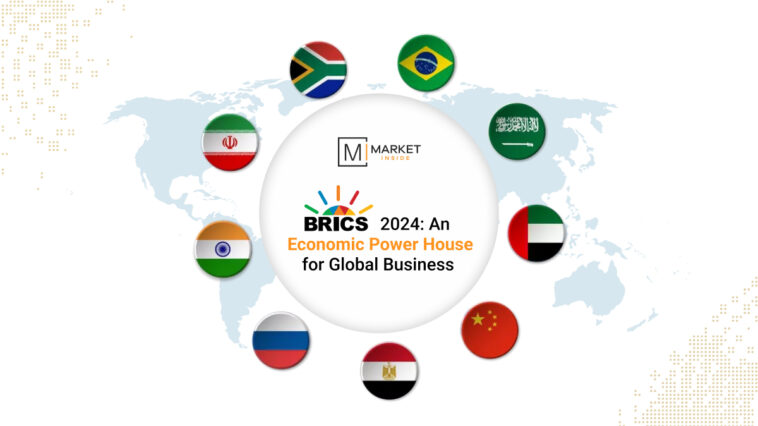Recently, BRICS, a group of five countries, gathered in Russia’s Kazan region to discuss alternative financial mechanisms, economic cooperation, multilateralism, and global governance. This alliance emerged in the early 2000s to strengthen the power of developing nations and reduce reliance on Western countries.
The group covers more than 40% of the global population and accounts for around 35% of the world’s GDP. The growing group influence threatens Western economic supremacy, signalling a shift towards a more multipolar world economy and a redefined global power balance. Let’s understand this –
BRICS: An Export Destination
The BRICS countries collectively have a major export potential due to their rich natural resources, manufacturing potential, and diversified economies. China and India are leading BRICS members in manufacturing and technology, while Brazil, Russia, and South Africa are major suppliers of Agricultural goods, oils, minerals, etc. Let’s understand their export value.
Also Read: China and Russia to Push De-dollarization Agenda in BRICS 2024
Surprisingly, the export value of all the major economies declined in 2023. China, Russia, India, Brazil, and South Africa’s exports decreased by $205, $430.9, $6.2, $5.2, and $13 billion, respectively. Russia’s exports to the world dropped drastically in 2023 compared to the previous year. The decline in the export value could be attributed to geopolitical challenges such as the Israel-Hamas conflict, the Russia-Ukraine conflict, and potential disruption to the oil supply in the Middle East region.

| BRICS Members | Exports In 2022 | Exports In 2023 |
| China | 3,593 | 3,388 |
| Russia | 941.1 | 510.2 |
| India | 452.6 | 446.4 |
| Brazil | 334.4 | 339.6 |
| South Africa | 123.6 | 110.6 |
Which Countries Have Joined BRICS in 2024?
The growing popularity of BRICS has attracted countries to join this trade bloc and reap its benefits. Countries from the Middle East, Latin America, and Africa see BRICS membership as an opportunity to access new trade routes, markets, and regions for investment. Saudi Arabia, Iran, UAE, Egypt, and Ethiopia joined BRICS in 2024. Here’s the trade value –
- As a member of the BRICS, UAE’s exports to the world ranked 3rd after China and Russia.
- In 2023, Saudi Arabia’s exports stood at $322.6 billion.
- Iran, Egypt, and Ethiopia’s export values stood at $91.1, $42, and $2.8 billion in 2023.
- BRICS as a trade bloc present tremendous export and import opportunities for all the members with potential free trade agreements.

| Exports By New BRICS Members | Export in 2023 |
| United Arab Emirates | 487.2 |
| Saudi Arabia | 322.6 |
| Iran | 91.1 |
| Egypt | 42 |
| Ethiopia | 2.8 |
Import Of Goods by BRICS Countries 2022-2023
We know that BRICS nations are a powerhouse of economic growth, contributing over 40% of the global population. This massive consumer base offers import opportunities for foreign businesses. Each member country presents a unique market for technology, healthcare, green energy, and agriculture, providing businesses with a path for expansion. Here’s the country-wise breakdown of the import value –
- Among the BRICS nations, China’s import value was more than $2.5 trillion in 2023, which decreased by $156 billion.
- China’s trillion-dollar import market showcases the diverse market gap that allows importers to seize the new opportunity.
- The imports of Russia, India, South Africa, and Brazil fell by $26.2, $77.52, $4.6, and $32 in 2023.
- The decline in the import value is attributed to the current geopolitical scenario and regional conflicts.

| Imports By BRICS Countries | Imports in 2022 | Imports in 2023 |
| China | 2,715 | 2,559 |
| Russia | 266.5 | 240.3 |
| India | 812.52 | 735 |
| South Africa | 111.8 | 107.2 |
| Brazil | 272.7 | 240.7 |
How BRICS Poses Threat on Western Countries’ Efforts to Isolate Russia?
In a recent meeting of the BRICS member countries, Russia has demonstrated the increasing influence of the bloc, and how it forming the new world order for trade and economic activity. Further, the bloc’s success shows the failure of Western efforts to isolate Russia. Here are the key ways in which BRICS members have challenged the Western isolation efforts –
Addition of Members –
Countries like Saudi Arabia, Egypt, UAE, and Iran joined the BRICS, and others have shown interest in joining the group. This significantly expands the BRICS’s global reach and influence. Russia’s deep engagement with BRICS members reduces the impact of sanctions and provides Russia with an additional market for its exports.
Economic Cooperation –
BRICS members continuously work on deepening economic ties by signing various trade agreements to reduce trade barriers, ease currency exchange, etc. For instance, BRICS members are considering launching a common currency for cross-border trade.
Diplomatic Platform –
The BRICS summit provides an international platform for its members to engage with other nations to discuss global trade, regional conflicts, and ways to increase economic activity. This summit connects and offers Russia a platform to engage with world leaders for better deals and trade.
The recent BRICS summit in Russia’s Kazan region demonstrates the significance of BRICS globally and sheds light on the failure of Western countries’ efforts to isolate the Russian Federation. Hence, it becomes important for the leaders of the global south and the global north to work in a constructive world economic order to boost regional connectivity and trade presence.




